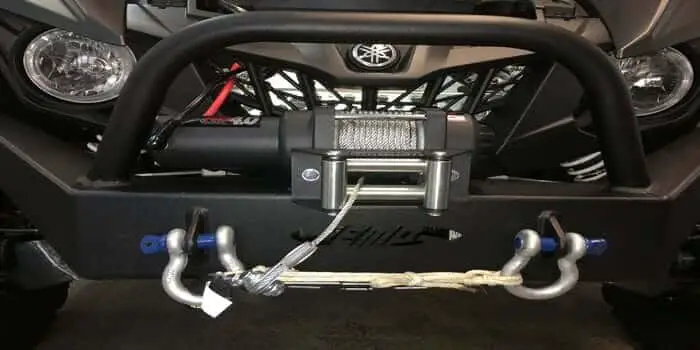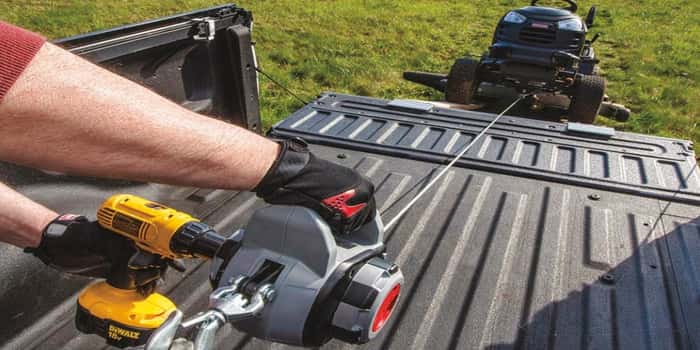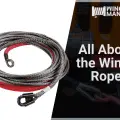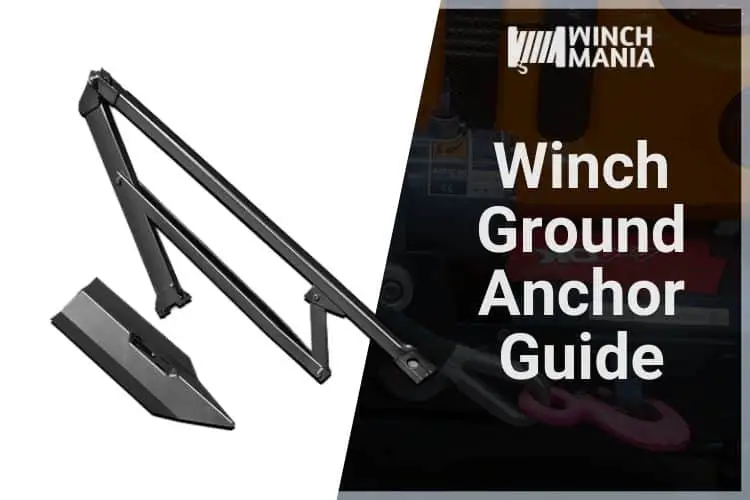From the first recorded use all the way back in 480 B.C. up until the present day, winches have helped people move big things they otherwise couldn’t. We’ve come a long way since then and there’s a lot to learn. So, let’s dive right into the the ultimate winch guide for offroading!
At a Glance
What is a winch?
A winch is mechanical tool used to manage the tension in a rope or wire by turning it around a spool. It can be simple and turned by hand or adapted for difficult tasks such as hauling vehicles or lifting jet skis.
These days, if you see a winch, it will likely be an electric winch powered by a battery or other electrical source. There is an entire industry that exists to serve the many unique use cases a winch may have.
What is a winch used for?
Fundamentally, a winch is used to lift or pull a heavy object towards the winch itself. Originally the Ancient Greeks saw the winch as an essential tool for large construction projects. They used cranes outfitted with winches to lift heavy objects for major projects like building the Parthenon. Usually, these winches were turned by men or animals.
Fast forward to today and now we have the power of electricity to help us operate our tools. This allows a winch to be used in a compact fashion, such as when attached to a truck or an ATV. Modern recreational uses for a winch include offroad vehicle recovery, pulling logs, and moving farm equipment.
From an off-roader’s perspective, mounted winches are a lifeline for when your vehicle gets stuck. You can have a strong engine, great suspension, and mean tires but ultimately you will get stuck and it’ll be your winch that saves you.
How does a winch work?
A winch works by the combined sum of its parts:
- A synthetic or braided steel wire wrapped around a rotating cylinder known as a drum, kind of like a fishing reel or a garden hose reel
- A spool inside the drum that allows it to rotate
- A power source, usually a motor powered by the vehicle’s battery or a hand crank
- A gear train that allows cranking power to translate into pulling power
- A hook on the opposite end of the wire that secures the object being pulled
Put these components all together and you’ll be able to move big weight like never before.
How can I use a winch safely?
A winch can be a dangerous piece of equipment if used improperly. Every situation that you might be stuck in is unique but be sure to follow these general guidelines.
- Always put on a pair of thick gloves before operating a winch. Metal fibers can peel off and easily cut through your hand. Don’t skip this step.
- In order to pull yourself out of a sticky situation, you’ll need a good anchor. This could be a boulder, low on a tree trunk, or another vehicle.
- Make sure your anchor is directly in front of your vehicle, otherwise you risk damaging the rope and your winch.
- Wrap your harness around the anchor you have chosen and connect the ends together within your “D” shackle. Do not simply wrap your wire around your anchor and hook it back.
- If using steel cable, it’s good practice to throw a heavy blanket, tow strap, or heavy coat onto the line in case it snaps. This can prevent a major accident.
- Make sure the area is clear. No one should be standing near the line.
- Keep your winch clean and well-maintained. Kinks in the line or rust buildup can impact performance and create unnecessary risk.
How to care for an offroad winch?
It’s no surprise that offroad adventures come with their fair share of mud and dust. Taking the proper steps to clean and maintain your winch will ensure its service for years to come. We recommend the following steps after every ride:
- Put on some gloves and save yourself the headache of a potential cut.
- Visually inspect the winch. If you were out for a while or had it submerged at any point, a full disassembly and cleaning will be needed.
- Remove the rope. If it’s synthetic and you don’t plan to ride for a while, you can keep it off to prevent UV damage and extend the life of the rope.
- Take a look at the electrical contacts for any corrosion. If they are wet, thoroughly dry them. Vinegar mixed with water should help remove any signs of corrosion.
- Check the gearbox and add lubricant if necessary. If it’s contaminated, disassemble and wash in kerosene before lubricating and reassembling.
- Inspect the solenoid contacts and along your power line. Make sure there are no kinks or exposure to sharp corners that could tear the electrical line.
- If you are planning to reinstall the rope, make sure to rinse, wash, clean and dry your line before you put it back on. Take the time to wind it tight with no overlap.
Reputable Brands
As with most important pieces of equipment, it’s important to choose a product from a reliable company. A winch could potentially save you from a sticky situation, so be sure to consider the following list. These companies each have their unique selling points and drawbacks. However, there is something great at every price point.
Warn Winch
One of the oldest and best-known winch brands in the world, WARN winches have been manufactured with pride in the Pacific Northwest for over 70 years. From their original focus on turning old military Jeeps into offroad machines WARN has blazed a path of innovation in all things offroad. WARN ranks highly for its attention to detail, quality of parts, and commitment to customer satisfaction. If this sounds good to you, you can read more about WARN winches by clicking here.
Smittybilt
A California based company focused on making great products to suit every outdoor need, Smittybilt has a rich heritage of innovation in the offroad industry. From winches to bumpers to camper tops, Smittybilt has seen – and made – it all. Not known to cut corners or complain, their reputation in the industry is so good they even back their products with a Lifetime Structural Warranty. Feel ready? Go ahead and click here to dive into the world of Smittybilt winches.
X-BULL
A new contender in the offroad world is none other than X-BULL. Their motto is “affordable toughness” and that is exactly what you’ll get. Perhaps some purists might argue X-BULL doesn’t deserve the same respect as WARN or Smittybilt. But, X-Bull charges a fraction of the price for their products. While not exactly a household name yet, we have found that their winches are more cost-effective given the smart pricing. If you are a price conscious shopper click here to read more about X-Bull winches.
Champion Power
While not exactly an offroad brand, Champion Power has a great reputation for making reliable ATV and UTV winches. While most other companies went after Jeeps and big trucks, Champion invested heavily into designing and manufacturing the industry’s best ATV winch equipment. If you’re in the market for an ATV winch, click to read more about what Champion has to offer.
Badland Winch
Whether you know or not, Badland winches are designed in sunny California and made entirely by Harbor Freight. With tens of millions of satisfied customers, Harbor Freight knows exactly what goes into a quality product. Using their extensive resources, they were able to create a winch for every need: from small ATV rescues to 12,000lb beasts. Interested? See how Badland winches perform under our tests right now.
VEVOR
Another great choice for quality tools is the lesser-known VEVOR. While not an offroad name brand, they have decades of experience manufacturing tough tools that get the job done. Much like Harbor Freight, they leverage their extensive resources to create quality products in-house. Their customer service is great, and we’ve had a chance to test out most of their winches in-depth. Check out the full rundown here.
Common Winch Accessories:
- Straps that range in size from 8 ft. to 30 ft. or more
- Wireless remote for ease of operation and safety
- D-ring shackles, most winches come with one as they are essential
- Synthetic cables with upgraded tensile strength
- Snatch blocks for doubling back and reducing strain on the wire
- Upgraded fairleads, which are the openings through which the wire extends
- Winch dampers to prevent extreme recoil in case of wire breaks
- Slings for lifting objects upwards
FAQ:
Which type of rope is better?
As technology advances, synthetic ropes made from plastic polymers are quickly becoming the preferred choice for good reasons. Overall synthetic rope is lighter and safer in the event that it snaps. It’s also easier to use and requires less maintenance which makes it the smarter choice for most people.
What weight capacity do I need?
Whether you plan to be pulling your own vehicle or moving another object you will need a load capacity at least 30% greater than the object being moved. To be safe, 50% greater is recommended.
How to install a winch?
How to install a winch will always depend on the specific instructions that come with the product. In general, you will need to keep mounting orientation, weight distribution, and power supply in mind during the installation process. You can read more in-depth instructions on how to install a winch here.
Sources:
https://www.smittybilt.com/about/
https://www.forbes.com/wheels/accessories/best-4×4-off-road-truck-winches/



